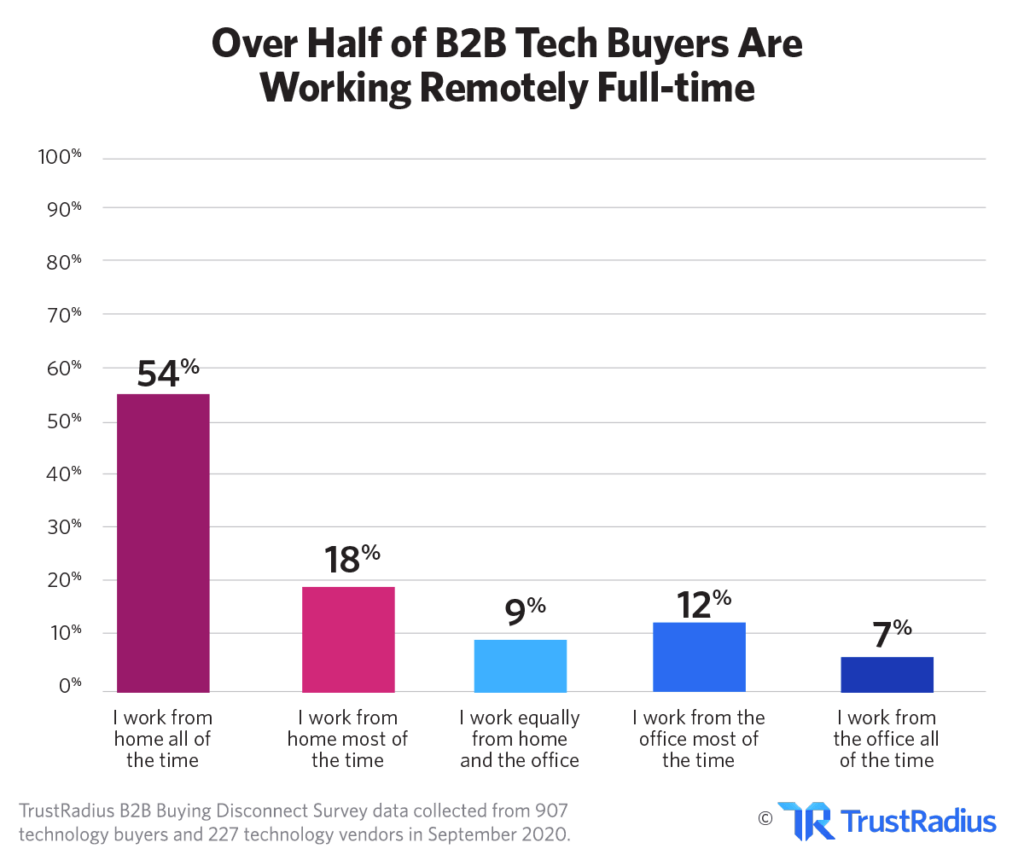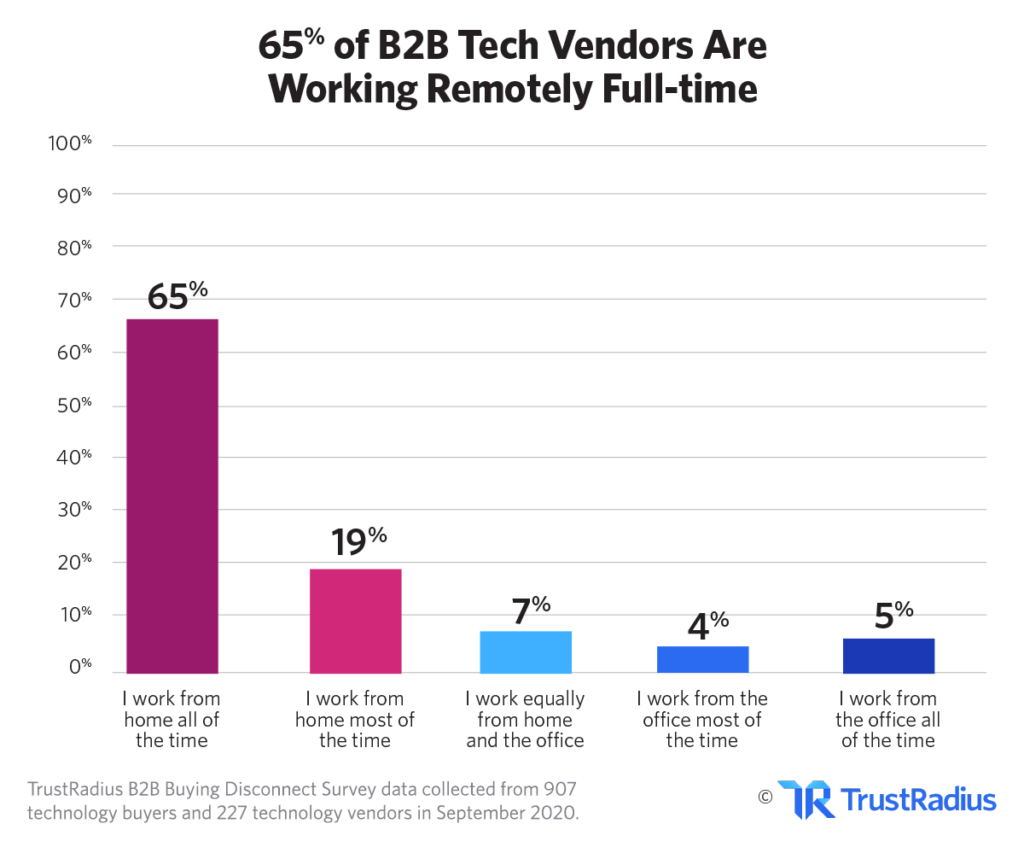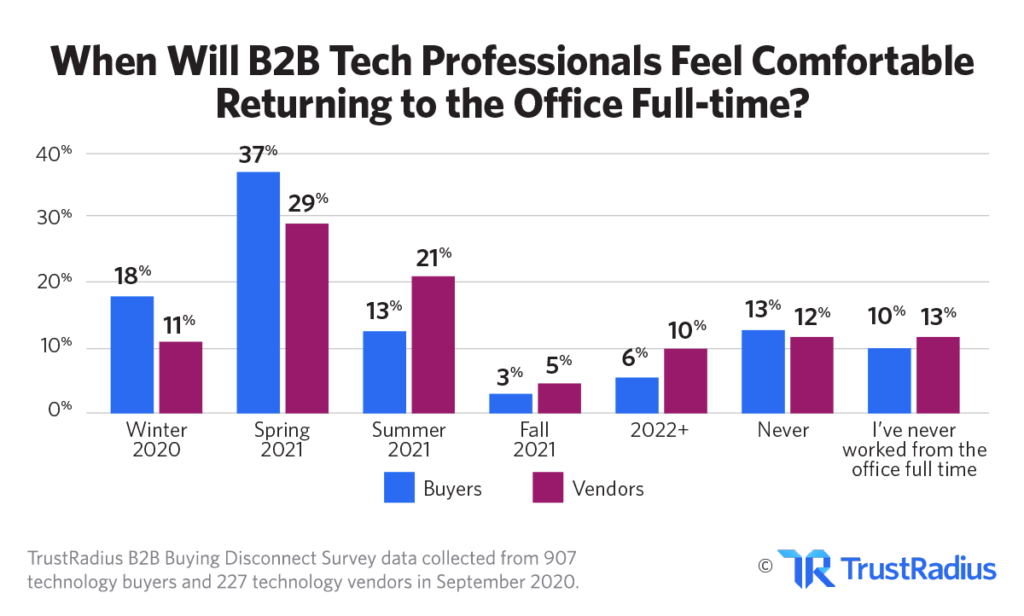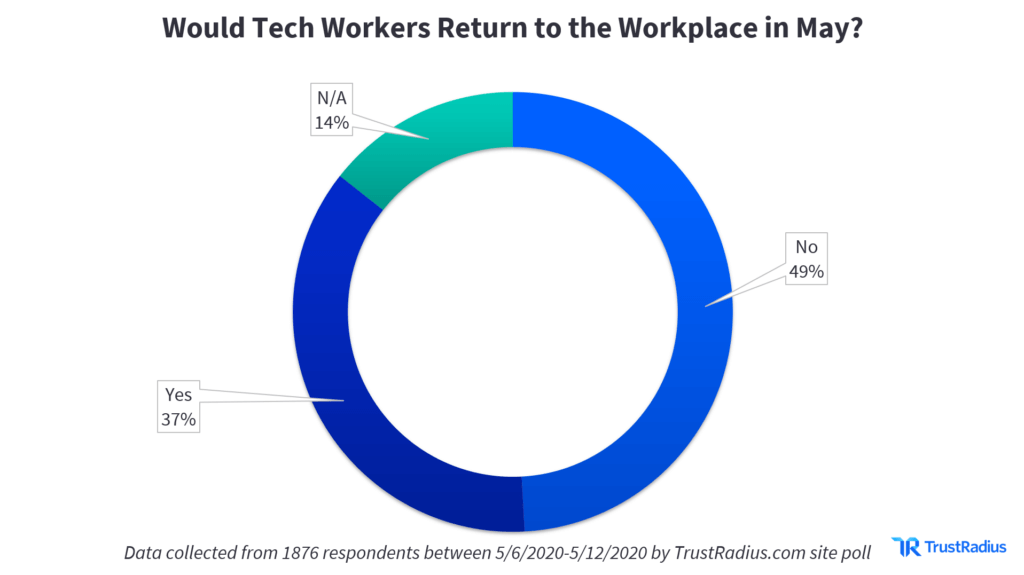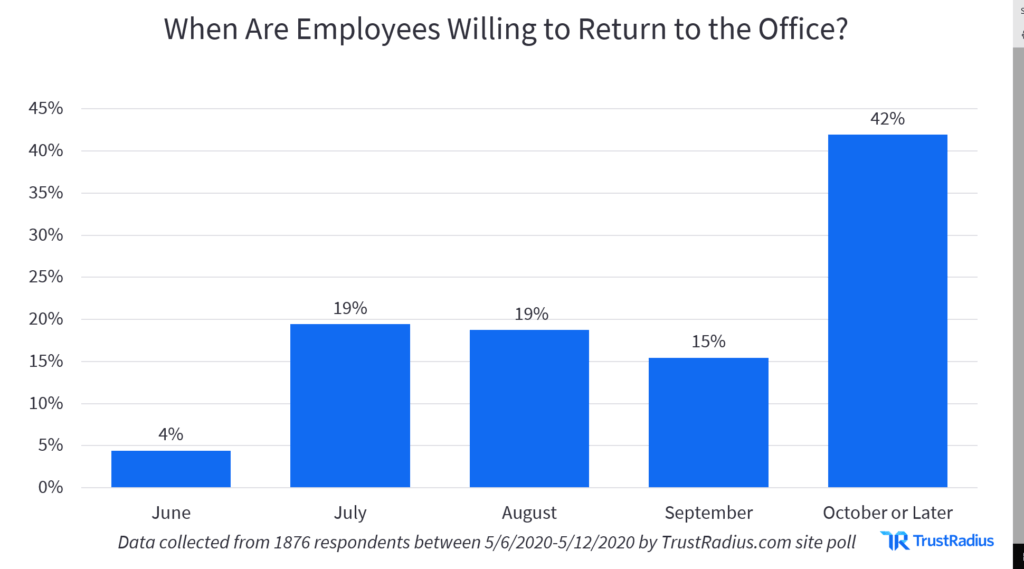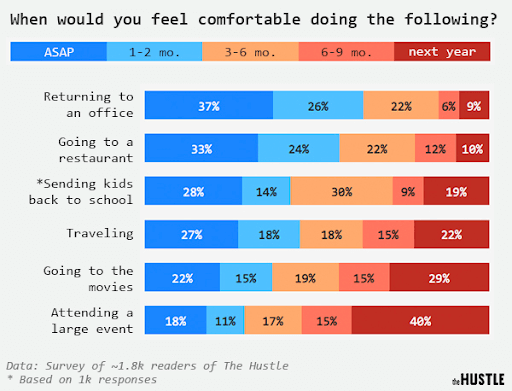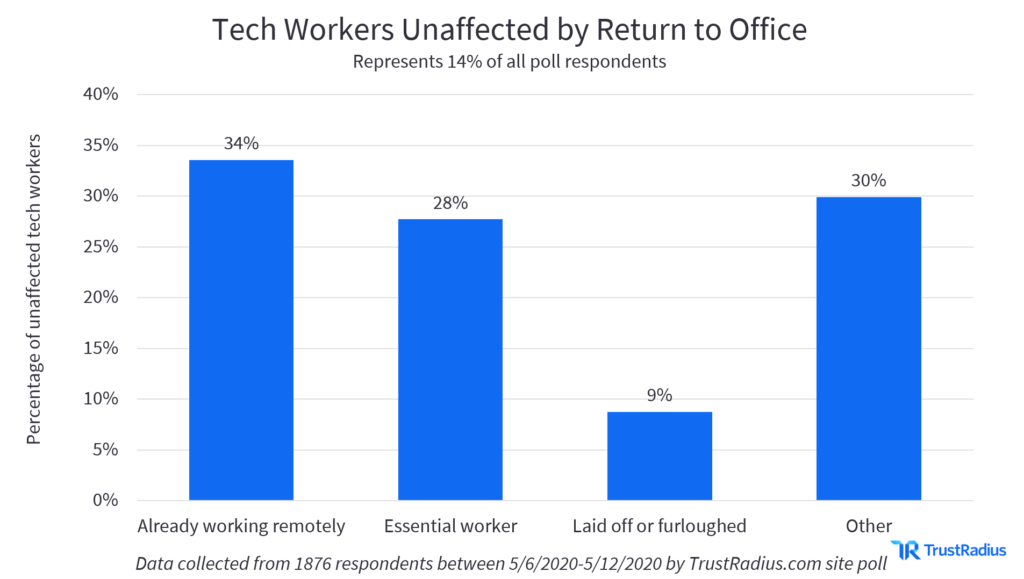When Are We Going Back to Work? New Tech Industry Data
**Updated December 11, 2020 with new data from the TrustRadius research team
COVID-19 cases in the United States are at an all-time high. But now that we have a COVID-19 vaccine at our fingertips, many tech industry professionals are starting to ask yet again: when are we going back to work?
We polled our TrustRadius community to get a pulse on how professionals feel about returning to the workplace, and when they would feel comfortable coming back.
Over Half of the Tech Industry is Still Remote
According to brand new research from TrustRadius, 54% of technology buyers are now working from home all of the time, with another 18% working from home most of the time. Only 7% of buyers work from the office all of the time, with another 12% working in offices most of the time.
Based on recent research from Gallup, which found that 1 out of 4 Americans are now working remotely 100% of the time, tech industry buyers are 2X as likely as the average U.S. worker to be working from home all of the time.
While the pandemic is still raging in many countries, working from home trends look different depending on the country. For example, British white-collar workers have been more reluctant to return to the office than white-collar workers in France, Germany, Italy, and Spain.
An even larger percentage of B2B tech vendors (65%) report working from home all of the time. Compared with the statistics from Gallup mentioned above, employees working for a technology vendor are 3X as likely to be fully remote than the average American worker.
Unlike other industries that require employees to be physically present to do their jobs, the tech industry is well-positioned to have a majority of employees work remotely—potentially permanently for some companies.
When Are We Going Back to Work in 2021?
Much like overall tech spending predictions for 2021, the forecast of when technology buyers and sellers will feel comfortable returning to office work fulltime remains uncertain.
- A majority of both buyers (72%) and vendors (76%) would not want to return to full-time office work until Spring 2021 or later.
- Another 13% of buyers and 12% of vendors say they would never feel comfortable work from the office full-time again.
- Notably, about 1 out of 10 buyers and vendors have never worked from their office full-time.
May 2020 Results: Would Tech Workers Return to Work?
According to our May 2020 poll of 1876 TrustRadius website visitors, a plurality of our community was opposed to returning to the workplace.
These results matched national polls which found that only a small minority of Americans support imminently reopening the economy. “Reopening the economy” is as much a personal decision as it is a political or macro-economic one. Our data suggests individuals were not yet comfortable with reopening in May 2020. Even if policies loosened, many professionals would be hesitant, if not outright opposed, to returning to their workplaces.
Nearly half of all respondents were not planning on an imminent return to the office. Even those willing to return to the office in May may not have felt comfortable while doing so. Office professionals may not experience the same COVID-related risks in their lines of work as frontline workers. But it’s still an open question of when, or even if, tech workers will return to the office.
When Are We Willing To Go Back to the Office?
If most tech professionals weren’t planning on a return to the office in May, when would they be willing to come back? For many members of the TrustRadius community that we surveyed in May 2020, that date wasn’t before the Fall. For some, it wasn’t until 2021.
Workers who weren’t predicting an imminent return said they plan to return to work in 6 months or more. The fact that a plurality of tech workers we surveyed were looking towards the winter or 2021 to return to the office presents a much longer timeline than other data sources currently report.
For instance, one study from The Hustle, published May 6th, pointed to a greater willingness to return to the office in the summer:
There’s a range of reasons why workers may have been willing to return to the office sooner rather than later. For instance, a separate TrustRadius study from May 11th found that over half of workers were experiencing increased familial duties and struggling with childcare, with a disproportionate burden on women. Over half of workers were also struggling to communicate with colleagues and stay engaged in the company culture while remote. Some may have been seeking to recoup lost income from furloughs or cut hours.
However, the severity of the pandemic may have tempered workers’ enthusiasm for reopening offices. External polling in May 2020 shows a majority of people who have lost income were still concerned that governments may reopen economies too quickly.
Workers may also have been setting longer return-to-work timelines for scientific or logistical reasons. Fears of a second wave of the virus in the fall may have encouraged workers to plan to stay at home. Parents may also have been tying their return to work plans to when kids could return to school—an uncertain prospect at the time, given conflicting signals from government officials.
How Comfortable Are Workers With Returning to the Workplace?
External factors could also have pressured employees into returning to the office before they felt comfortable doing so. Of those respondents who said they were willing to return to the office in May 2020, 16% said they would not feel comfortable doing so.
The disconnect between “willing to return” and “comfortable returning” suggests that some workers felt pressure to re-enter social/professional settings before they felt safe or secure in those environments.
Prior research from TrustRadius shows that 1 in 3 workers felt pressure to be more productive after the pandemic. The same study found that just as many workers were also newly balancing round-the-clock childcare on top of professional obligations.
Employees feeling the strain of working from home under these conditions may have been more willing to return to a less distracting environment, even if there was greater risk involved. Managers and business owners should still be cognizant of health concerns that even compliant workers may have, and take steps to ensure workers’ safety.
Returning to Work Isn’t Always a Question of “When”
As many of us navigate whether, or how, to return to the office, we should remember that not everyone is experiencing the same path through COVID-19.
In our research, 14% of respondents said that the question of returning to work in May, and the implied internal debate between career and health, was not applicable to them. This segment of the TrustRadius audience represented essential workers, those who have already lost their jobs, and workers who were already remote, along with others who have had to remain on-premises.
Noteworthy within this segment of respondents is the percentage of workers who were already remote prior to the pandemic. Prior research from TrustRadius on COVID-19’s impact on software spending suggests that roughly 15% of organizations were already prepared for remote work or already working remotely. For these workers, there was no necessity to return to the office in order to do their jobs. Instead, they demonstrated the viability of remote or distributed workers in various industries.
This begs the question of whether workers must return to the workplace at all?
Over the course of 2020, many tech companies made the logistical transition to fully-remote workforces. These investments in infrastructure, software, and processes may have also reduced the need for workspaces to rush to reopen in the same way as the service sector.
Where Do Businesses Go From Here?
The general consensus from the TrustRadius audience is that returning to the workplace should be optional and taken very slowly with an eye towards local conditions. If offices reopen, there is still a risk of needing to reclose at any time. Instead, many tech companies will maintain current remote work policies through the beginning of 2021. This policy gives employees the flexibility necessary to balance their professional and personal obligations.
Some organizations are taking this opportunity to make current WFH policies a permanent option for their employees. Some tech giants, such as Facebook, have already established plans to allow employees to work remotely through the end of 2020. Twitter’s CEO announced a permanent “work from home” policy for nearly all employees, setting a precedent for other tech companies to follow.
As companies evaluate return to work strategies, marketing and sales teams are also eyeing how these changes impact their pipeline and sales cycles. To assist our community, we provide category-level and product-level intent data for software vendors who want to keep a pulse on the market.





